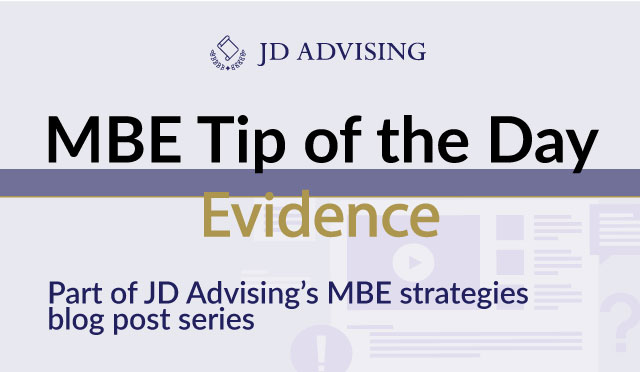MBE Tip of the Day: Evidence
MBE Tip of the Day: Evidence
Welcome to our MBE tip of the day series. This MBE post focuses on Evidence.
There are 25 scored Evidence MBE questions on the Multistate Bar Exam. In this post, we will review an Evidence question together. Note that we have posted several MBE tips (which you can find links to at the bottom of this post) that focus on a specific multiple-choice question that many students answer incorrectly. If you can master these questions, it could increase your MBE score by that many points if you see any of these issues tested again (which, by the way, you will!). These posts of MBE tips and tricks will not only cover substantive law but also strategy. So each “MBE tip of the day” post covers one highly-tested area of substantive law as well as an important MBE strategy. You can sign up to receive these posts directly to your inbox for the upcoming administration at the bottom of this page.
MBE Tip of the Day Instructions:
Do your best to answer this Evidence MBE question (before even looking at the answer choices and before looking at the answer below!) Ask yourself: What is the subject? What is the legal issue? What is the rule and analysis? What is the conclusion? Try to answer these beginning questions before even reading the answer choices. Then, uncover the answer as well as read more about our MBE tip of the day.
Show the MBE Question...
Evidence MBE Question
A defendant is charged with homicide after the defendant was involved in a car accident that killed a pedestrian. At the defendant’s trial, the prosecution called to the stand a shop-owner who testified that immediately after the accident, a witness ran into his store and said: “Whoa!! Can I use your phone? That blue car just ran a red light and hit someone!” The witness is not testifying at trial and is not present in court. With the sole objective of discrediting this testimony, the defense sought to introduce an audio recording from when a police officer interviewed the witness at the station the next day. The recording consists of the following exchange:
Officer: “Did you see a blue car run a red light?”
Witness: “No. The blue car did not run a red light. The light was green when it drove through the intersection.”
The prosecution objected to the introduction of the recording. Assume that the recording and the voices are properly authenticated and satisfy the best evidence rule.
Should the court sustain the objection?
(A) Yes, because the recording constitutes inadmissible hearsay.
(B) Yes, because extrinsic evidence is not admissible in this situation.
(C) No, because the recording constitutes admissible hearsay under the past recollection recorded exception.
(D) No, because extrinsic evidence is admissible in this situation.
Subject:
Legal Issue:
Legal Rule and Analysis:
Choose an answer choice that most closely matches your conclusion and explain why the others are incorrect:
Show the Answer to the Evidence MBE Question...
Answer to the Evidence MBE Question
Subject: Evidence
Legal Issue: When is extrinsic evidence admissible to impeach a witness based on a prior inconsistent statement?
Legal Rule and Analysis: If a witness has made a statement that is inconsistent with their testimony at trial, it can be used for impeachment purposes. It can only be admitted as substantive evidence (i.e. to prove the truth of the matter asserted) if it meets a hearsay exception or exclusion. However, here we are told that the tape is not being offered for the truth of the matter but only to discredit (or impeach) the declarant. Thus, hearsay is not an issue.
The rules regarding impeachment through prior inconsistent statements can also be used to impeach a witness-declarant that is not testifying at trial. Ordinarily, extrinsic evidence (which is a fancy way of saying “outside evidence” – such as a tape recording) of prior inconsistent statements can only be presented if the witness is given an opportunity to explain or deny the statement at some point in court. However, this rule does not apply when:
- (1) the witness is the opposing party,
- (2) the witness is not in court at all, or
- (3) when the interests of justice require
In this case, we have a non-testifying witness whose statement is being offered at trial through a shop-owner. The defense is seeking to discredit the witness by offering evidence of a second statement made by the witness that is inconsistent with the testimony. Thus, the defense is trying to impeach the witness. (If you applied hearsay rules, pay careful attention to the reason the evidence is being offered!)
A recording of the conversation between the witness and the officer constitutes extrinsic evidence as it is outside evidence being brought into court. Extrinsic evidence isn’t admissible to impeach based on a prior inconsistent statement when the witness isn’t provided the opportunity to explain or deny the statement on the stand unless one of the exceptions are met. In the facts, we are told that the witness is not testifying at trial and is not present in court. Therefore, exception (2) listed above is met. Extrinsic evidence will be admissible to prove that the witness made a prior statement inconsistent with the testimony. However, the evidence will not be admissible as proof that the defendant did not run a red light. (The statement the witness gave to the police officer was not under oath, and so it does not meet the prior inconsistent statement hearsay exception. Nor does it meet any other hearsay exception or exclusion based on the facts we are given. Further, we are told that the statement is only being offered for impeachment. Thus, we do not have to worry about a hearsay exception or exclusion.)
Conclusion: Since the witness is not testifying at trial, the recording will be admissible as extrinsic evidence of the witness’s prior inconsistent statement.
Look at the answer choices provided. Choose an answer choice that matches your conclusion. Review the other answer choices provided. The answer choice (D) is therefore correct. (A) is incorrect because the statements made in the recording do not meet the definition of hearsay. Hearsay is an out of court statement offered to prove the truth of the matter asserted. The defense is not offering the recording to prove the truth of the statements made on it. Rather, it is offering the recording to impeach the witness’s credibility. Therefore, the statements made in the recording are not hearsay. (B) is incorrect because, as stated above, extrinsic evidence is admissible when the witness does not appear in court. (C) is incorrect because the recording does not meet the requirements for the past recollection recorded exception, even if it were being offered to prove the truth of the matter asserted. To be admissible under this exception, we need to have a witness on the stand who has insufficient recollection of the incident while testifying. Here there is no witness on the stand who is having trouble remember what they are to be testifying to.
MBE Tip: In order to understand exactly what the call of the question is asking, it is important to know the definitions of basic legal terms! In this problem, the call asks you whether the prosecution’s objection should be “sustained.” If you do not know that sustaining an objection (as opposed to overruling it) means to grant the objection, or to uphold it as valid, then you will not know how to properly answer the question. You might think that the appropriate answer should be a “yes” choice instead of a “no” choice. Understanding legal terminology will allow you to frame the question correctly.
It is also important to pay attention to exactly what the question is asking. If you started undergoing a hearsay analysis, remind yourself to slow down and focus on exactly what the question is asking–that is, whether the statement may be used for impeachment.
Show Summary of the Two Key Takeaway Points for the Day
Key Takeaways and MBE Tips From Prior Posts
Takeaway for the Law: Ordinarily extrinsic evidence is not allowed to impeach a witness based on a prior inconsistent statement unless the witness has an opportunity to explain or deny the statement. The exceptions to this rule are when the witness is the opposing party, when the witness is not in court at all, and when the interests of justice require.
MBE Tip: Understanding the definitions of legal terms will help you know exactly what the question is asking. Further, make sure to pay attention to exactly what the question is asking. If you started undergoing a hearsay analysis, remind yourself to slow down and focus on exactly what the question is asking.
Want to See Past MBE Tip of the Day Posts?
If you would like to see “MBE tip of the day” posts from prior days, please check out all of our past MBE tip of the day archives here! We have several of them and we list them by subject!
Looking for additional MBE help?
If you are looking for MBE help, read our 10 expert MBE tips here. Check out our step-by-step guide to improving your MBE score, please review this post for an overview of tips. If you would like to have the next MBE tip emailed to you when we come out with another one, please fill out the form below.
MBE Tip of the Day
Seeking MBE Assistance?
Seeking MBE Assistance?
- 📘 MBE Guide: Equip yourself with our FREE expert-crafted bar exam and MBE guides.
- Free Bar Exam Resource Center: Discover top resources, articles, and free webinars led by renowned bar exam professionals.
Top Resources as Vouched by our Students:
- MBE One-Sheets: One of our most highly acclaimed bar exam supplements!
- Bar Exam Outlines: Our comprehensive and condensed bar exam outlines present key information in an organized, easy-to-digest layout.
- MBE Private Tutoring: Opt for personalized, effective strategies.
- On Demand Bar Exam Course: Comprehensive bar exam preparation.
- Bar Exam Crash Course and Mini Outlines: Acclaimed and effective for a quick refresher.
- MBE Mastery Class, Real MBE Questions, and MBE Guide: Elevate your MBE preparation with these high-quality MBE supplements!
🔥 NEW! Check out our Repeat Taker Bar Exam Course and get introduced to our unmatched platinum Guarantee Pass Program.






